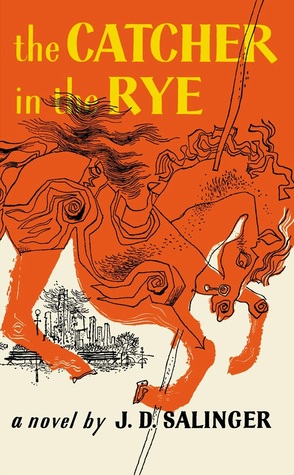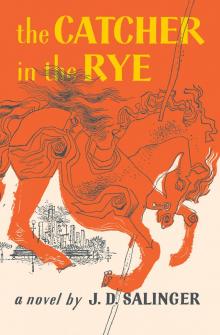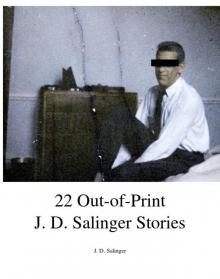- Home
- J. D. Salinger
For Esmé, With Love and Squalor Page 6
For Esmé, With Love and Squalor Read online
Page 6
(It took the Chief a couple of months to get that far into the story. From there on in, he got more and more high-handed with his installments, entirely to the satisfaction of the Comanches.)
The Laughing Man was one for keeping an ear to the ground, and in no time at all he had picked up the bandits’ most valuable trade secrets. He didn’t think much of them, though, and briskly set up his own, more effective system. On a rather small scale at first, he began to free-lance around the Chinese countryside, robbing, highjacking, murdering when absolutely necessary. Soon his ingenious criminal methods, coupled with his singular love of fair play, found him a warm place in the nation’s heart. Strangely enough, his foster parents (the bandits who had originally turned his head toward crime) were about the last to get wind of his achievements. When they did, they were insanely jealous. They all single-filed past the Laughing Man’s bed one night, thinking they had successfully doped him into a deep sleep, and stabbed at the figure under the covers with their machetes. The victim turned out to be the bandit chief’s mother—an unpleasant, haggling sort of person. The event only whetted the bandits’ taste for the Laughing Man’s blood, and finally he was obliged to lock up the whole bunch of them in a deep but pleasantly decorated mausoleum. They escaped from time to time and gave him a certain amount of annoyance, but he refused to kill them. (There was a compassionate side to the Laughing Man’s character that just about drove me crazy.)
Soon the Laughing Man was regularly crossing the Chinese border into Paris, France, where he enjoyed flaunting his high but modest genius in the face of Marcel Dufarge, the internationally famous detective and witty consumptive. Dufarge and his daughter (an exquisite girl, though something of a transvestite) became the Laughing Man’s bitterest enemies. Time and again, they tried leading the Laughing Man up the garden path. For sheer sport, the Laughing Man usually went halfway with them, then vanished, often leaving no even faintly credible indication of his escape method. Just now and then he posted an incisive little farewell note in the Paris sewerage system, and it was delivered promptly to Dufarge’s boot. The Dufarges spent an enormous amount of time sloshing around in the Paris sewers.
Soon the Laughing Man had amassed the largest personal fortune in the world. Most of it he contributed anonymously to the monks of a local monastery—humble ascetics who had dedicated their lives to raising German police dogs. What was left of his fortune, the Laughing Man converted into diamonds, which he lowered casually, in emerald vaults, into the Black Sea. His personal wants were few. He subsisted exclusively on rice and eagles’ blood, in a tiny cottage with an underground gymnasium and shooting range, on the stormy coast of Tibet. Four blindly loyal confederates lived with him: a glib timber wolf named Black Wing, a lovable dwarf named Omba, a giant Mongolian named Hong, whose tongue had been burned out by white men, and a gorgeous Eurasian girl, who, out of unrequited love for the Laughing Man and deep concern for his personal safety, sometimes had a pretty sticky attitude toward crime. The Laughing Man issued his orders to the crew through a black silk screen. Not even Omba, the lovable dwarf, was permitted to see his face.
I’m not saying I will, but I could go on for hours escorting the reader—forcibly, if necessary—back and forth across the Paris-Chinese border. I happen to regard the Laughing Man as some kind of super-distinguished ancestor of mine—a sort of Robert E. Lee, say, with the ascribed virtues held under water or blood. And this illusion is only a moderate one compared to the one I had in 1928, when I regarded myself not only as the Laughing Man’s direct descendant but as his only legitimate living one. I was not even my parents’ son in 1928 but a devilishly smooth impostor, awaiting their slightest blunder as an excuse to move in—preferably without violence, but not necessarily—to assert my true identity. As a precaution against breaking my bogus mother’s heart, I planned to take her into my underworld employ in some undefined but appropriately regal capacity. But the main thing I had to do in 1928 was watch my step. Play along with the farce. Brush my teeth. Comb my hair. At all costs, stifle my natural hideous laughter.
Actually, I was not the only legitimate living descendant of the Laughing Man. There were twenty-five Comanches in the Club, or twenty-five legitimate living descendants of the Laughing Man—all of us circulating ominously, and incognito, throughout the city, sizing up elevator operators as potential archenemies, whispering side-of-the-mouth but fluent orders into the ears of cocker spaniels, drawing beads, with index fingers, on the foreheads of arithmetic teachers. And always waiting, waiting for a decent chance to strike terror and admiration in the nearest mediocre heart.
One afternoon in February, just after Comanche baseball season had opened, I observed a new fixture in the Chief’s bus. Above the rear-view mirror over the windshield, there was a small, framed photograph of a girl dressed in academic cap and gown. It seemed to me that a girl’s picture clashed with the general men-only décor of the bus, and I bluntly asked the Chief who she was. He hedged at first, but finally admitted that she was a girl. I asked him what her name was. He answered unforthrightly, “Mary Hudson.” I asked him if she was in the movies or something. He said no, that she used to go to Wellesley College. He added, on some slow-processed afterthought, that Wellesley College was a very high class college. I asked him what he had her picture in the bus for, though. He shrugged slightly, as much as to imply, it seemed to me, that the picture had more or less been planted on him.
During the next couple of weeks, the picture—however forcibly or accidentally it had been planted on the Chief—was not removed from the bus. It didn’t go out with the Baby Ruth wrappers and the fallen licorice whips. However, we Comanches got used to it. It gradually took on the unarresting personality of a speedometer.
But one day as we were on our way to the Park, the Chief pulled the bus over to a curb on Fifth Avenue in the Sixties, a good half mile past our baseball field. Some twenty back-seat drivers at once demanded an explanation, but the Chief gave none. Instead, he simply got into his story-telling position and swung prematurely into a fresh installment of “The Laughing Man.” He had scarcely begun, however, when someone tapped on the bus door. The Chief’s reflexes were geared high that day. He literally flung himself around in his seat, yanked the operating handle of the door, and a girl in a beaver coat climbed into the bus.
Offhand, I can remember seeing just three girls in my life who struck me as having unclassifiably great beauty at first sight. One was a thin girl in a black bathing suit who was having a lot of trouble putting up an orange umbrella at Jones Beach, circa 1936. The second was a girl aboard a Caribbean cruise ship in 1939, who threw her cigarette lighter at a porpoise. And the third was the Chief’s girl, Mary Hudson.
“Am I very late?” she asked the Chief, smiling at him.
She might just as well have asked if she was ugly.
“No!” the Chief said. A trifle wildly, he looked at the Comanches near his seat and signalled the row to give way. Mary Hudson sat down between me and a boy named Edgar something, whose uncle’s best friend was a bootlegger. We gave her all the room in the world. Then the bus started off with a peculiar, amateur-like lurch. The Comanches, to the last man, were silent.
On the way back to our regular parking place, Mary Hudson leaned forward in her seat and gave the Chief an enthusiastic account of the trains she had missed and the train she hadn’t missed; she lived in Douglaston, Long Island. The Chief was very nervous. He didn’t just fail to contribute any talk of his own; he could hardly listen to hers. The gearshift knob came off in his hand, I remember.
When we got out of the bus, Mary Hudson stuck right with us. I’m sure that by the time we reached the baseball field there was on every Comanche’s face a some-girls-just-don’t-know-when-to-go-home look. And to really top things off, when another Comanche and I were flipping a coin to decide which team would take the field first, Mary Hudson wistfully expressed a desire to join the game. The response to this couldn’t have been more
clean-cut. Where before we Comanches had simply stared at her femaleness, we now glared at it. She smiled back at us. It was a shade disconcerting. Then the Chief took over, revealing what had formerly been a well-concealed flair for incompetence. He took Mary Hudson aside, just out of earshot of the Comanches, and seemed to address her solemnly, rationally. At length, Mary Hudson interrupted him, and her voice was perfectly audible to the Comanches. “But I do,” she said. “I do, too, want to play!” The Chief nodded and tried again. He pointed in the direction of the infield, which was soggy and pitted. He picked up a regulation bat and demonstrated its weight. “I don’t care,” Mary Hudson said distinctly, “I came all the way to New York—to the dentist and everything—and I’m gonna play.” The Chief nodded again but gave up. He walked cautiously over to home plate, where the Braves and the Warriors, the two Comanche teams, were waiting, and looked at me. I was captain of the Warriors. He mentioned the name of my regular center fielder, who was home sick, and suggested that Mary Hudson take his place. I said I didn’t need a center fielder. The Chief asked me what the hell did I mean I didn’t need a center fielder. I was shocked. It was the first time I had heard the Chief swear. What’s more, I could feel Mary Hudson smiling at me. For poise, I picked up a stone and threw it at a tree.
We took the field first. No business went out to center field the first inning. From my position on first base, I glanced behind me now and then. Each time I did, Mary Hudson waved gaily to me. She was wearing a catcher’s mitt, her own adamant choice. It was a horrible sight.
Mary Hudson batted ninth on the Warriors’ lineup. When I informed her of this arrangement, she made a little face and said, “Well, hurry up, then.” And as a matter of fact we did seem to hurry up. She got to bat in the first inning. She took off her beaver coat—and her catcher’s mitt—for the occasion and advanced to the plate in a dark-brown dress. When I gave her a bat, she asked me why it was so heavy. The Chief left his umpire’s position behind the pitcher and came forward anxiously. He told Mary Hudson to rest the end of her bat on her right shouder. “I am,” she said. He told her not to choke the bat too tightly. “I’m not,” she said. He told her to keep her eye right on the ball. “I will,” she said. “Get outa the way.” She swung mightily at the first ball pitched to her and hit it over the left fielder’s head. It was good for an ordinary double, but Mary Hudson got to third on it—standing up.
When my astonishment had worn off, and then my awe, and then my delight, I looked over at the Chief. He didn’t so much seem to be standing behind the pitcher as floating over him. He was a completely happy man. Over on third base, Mary Hudson waved to me. I waved back. I couldn’t have stopped myself, even if I’d wanted to. Her stickwork aside, she happened to be a girl who knew how to wave to somebody from third base.
The rest of the game, she got on base every time she came to bat. For some reason, she seemed to hate first base; there was no holding her there. At least three times, she stole second.
Her fielding couldn’t have been worse, but we were piling up too many runs to take serious notice of it. I think it would have improved if she’d gone after flies with almost anything except a catcher’s mitt. She wouldn’t take it off, though. She said it was cute.
The next month or so, she played baseball with the Comanches a couple of times a week (whenever she had an appointment with her dentist, apparently). Some afternoons she met the bus on time, some afternoons she was late. Sometimes she talked a blue streak in the bus, sometimes she just sat and smoked her Herbert Tareyton cigarettes (cork-tipped). When you sat next to her in the bus, she smelled of a wonderful perfume.
One wintry day in April, after making his usual three o’clock pickup at 109th and Amsterdam, the Chief turned the loaded bus east at 110th Street and cruised routinely down Fifth Avenue. But his hair was combed wet, he had on his overcoat instead of his leather windbreaker, and I reasonably surmised that Mary Hudson was scheduled to join us. When we zipped past our usual entrance to the Park, I was sure of it. The Chief parked the bus on the comer in the Sixties appropriate to the occasion. Then, to kill time painlessly for the Comanches, he straddled his seat backward and released a new installment of “The Laughing Man.” I remember the installment to the last detail, and I must outline it briefly.
A flux of circumstances delivered the Laughing Man’s best friend, his timber wolf, Black Wing, into a physical and intellectual trap set by the Dufarges. The Dufarges, aware of the Laughing Man’s high sense of loyalty, offered him Black Wing’s freedom in exchange for his own. In the best faith in the world, the Laughing Man agreed to these terms. (Some of the minor mechanics of his genius were often subject to mysterious little breakdowns.) It was arranged for the Laughing Man to meet the Dufarges at midnight in a designated section of the dense forest surrounding Paris, and there, by moonlight, Black Wing would be set free. However, the Dufarges had no intention of liberating Black Wing, whom they feared and loathed. On the night of the transaction, they leashed a stand-in timber wolf for Black Wing, first dyeing its left hind foot snow white, to look like Black Wing’s.
But there were two things the Dufarges hadn’t counted on: the Laughing Man’s sentimentality and his command of the timber-wolf language. As soon as he had allowed Dufarge’s daughter to tie him with barbed wire to a tree, the Laughing Man felt called upon to raise his beautiful, melodious voice in a few words of farewell to his supposed old friend. The stand-in, a few moonlit yards away, was impressed by the stranger’s command of the language and listened politely for a moment to the last-minute advice, personal and professional, that the Laughing Man was giving out. At length, though, the stand-in grew impatient and began shifting his weight from paw to paw. Abruptly, and rather unpleasantly, he interrupted the Laughing Man with the information that, in the first place, his name wasn’t Dark Wing or Black Wing or Gray Legs or any of that business, it was Armand, and, in the second place, he’d never been to China in his life and hadn’t the slightest intention of going there.
Properly infuriated, the Laughing Man pushed off his mask with his tongue and confronted the Dufarges with his naked face by moonlight. Mlle. Dufarge responded by passing out cold. Her father was luckier. By chance, he was having one of his coughing spells at the moment and thereby missed the lethal unveiling. When his coughing spell was over and he saw his daughter stretched out supine on the moonlit ground, Dufarge put two and two together. Shielding his eyes with his hand, he fired the full clip in his automatic toward the sound of the Laughing Man’s heavy, sibilant breathing.
The installment ended there.
The Chief took his dollar Ingersoll out of his watch pocket, looked at it, then swung around in his seat and started up the motor. I checked my own watch. It was almost four-thirty. As the bus moved forward, I asked the Chief if he wasn’t going to wait for Mary Hudson. He didn’t answer me, and before I could repeat my question, he tilted back his head and addressed all of us: “Let’s have a little quiet in this damn bus.” Whatever else it may have been, the order was basically unsensible. The bus had been, and was, very quiet. Almost everybody was thinking about the spot the Laughing Man had been left in. We were long past worrying about him—we had too much confidence in him for that—but we were never past accepting his most perilous moments quietly.
In the third or fourth inning of our ball game that afternoon, I spotted Mary Hudson from first base. She was sitting on a bench about a hundred yards to my left, sandwiched between two nursemaids with baby carriages. She had on her beaver coat, she was smoking a cigarette, and she seemed to be looking in the direction of our game. I got excited about my discovery and yelled the information over to the Chief, behind the pitcher. He hurried over to me, not quite running. “Where?” he asked me. I pointed again. He stared for a moment in the right direction, then said he’d be back in a minute and left the field. He left it slowly, opening his overcoat and putting his hands in the hip pockets of his trousers. I sat down on first base and watched. By
the time the Chief reached Mary Hudson, his overcoat was buttoned again and his hands were down at his sides.
He stood over her for about five minutes, apparently talking to her. Then Mary Hudson stood up, and the two of them walked toward the baseball field. They didn’t talk as they walked, or look at each other. When they reached the field, the Chief took his position behind the pitcher. I yelled over to him. “Isn’t she gonna play?” He told me to cover my sack. I covered my sack and watched Mary Hudson. She walked slowly behind the plate, with her hands in the pockets of her beaver coat, and finally sat down on a misplaced players’ bench just beyond third base. She lit another cigarette and crossed her legs.
When the Warriors were at bat, I went over to her bench and asked her if she felt like playing left field. She shook her head. I asked her if she had a cold. She shook her head again. I told her I didn’t have anybody in left field. I told her I had a guy playing center field and left field. There was no response at all to this information. I tossed my first-baseman’s mitt up in the air and tried to have it land on my head, but it fell in a mud puddle. I wiped it off on my trousers and asked Mary Hudson if she wanted to come up to my house for dinner sometime. I told her the Chief came up a lot. “Leave me alone,” she said. “Just please leave me alone.” I stared at her, then walked off in the direction of the Warriors’ bench, taking a tangerine out of my pocket and tossing it up in the air. About midway along the third-base foul line, I turned around and started to walk backwards, looking at Mary Hudson and holding on to my tangerine. I had no idea what was going on between the Chief and Mary Hudson (and still haven’t, in any but a fairly low, intuitive sense), but nonetheless, I couldn’t have been more certain that Mary Hudson had permanently dropped out of the Comanche lineup. It was the kind of whole certainty, however independent of the sum of its facts, that can make walking backwards more than normally hazardous, and I bumped smack into a baby carriage.

 Catcher in the Rye
Catcher in the Rye Raise High the Roof Beam, Carpenters & Seymour: An Introduction
Raise High the Roof Beam, Carpenters & Seymour: An Introduction For Esmé, With Love and Squalor
For Esmé, With Love and Squalor Nine Stories
Nine Stories Franny and Zooey
Franny and Zooey The Catcher in the Rye
The Catcher in the Rye Three Stories
Three Stories 22 Out-of-print J. D. Salinger Stories
22 Out-of-print J. D. Salinger Stories